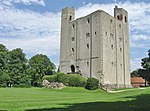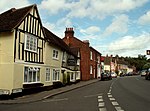Sible Hedingham

Sible Hedingham ( SIB-əl HED-ing-əm) is a large village and civil parish in the Colne Valley in the Braintree District of Essex, in England. It has a population of 3,994 according to the 2011 census. Sible Hedingham lies in the northern corner of Essex, close to both the Suffolk and Cambridgeshire borders. The village covers some 2,123 hectares (5,246 acres). The Domesday Book of 1086 lists the village together with Hedingham Castle amongst the lands given to Roger Bigod by the king. The land included woodland for 70 pigs that was in total valued at £4. A variation on the village name is "Hengham Sybyle".In 1863, Sible Hedingham was the site of one of the last 19th-century witchcraft accusations in England. The victim is now known as "Dummy, the Witch of Sible Hedingham". The village is twinned with the French commune of Choisy-au-Bac, located in Picardy region, Oise department (c. 80 km north of Paris, near Compiègne).
Excerpt from the Wikipedia article Sible Hedingham (License: CC BY-SA 3.0, Authors, Images).Sible Hedingham
Osier Way, Essex
Geographical coordinates (GPS) Address Nearby Places Show on map
Geographical coordinates (GPS)
| Latitude | Longitude |
|---|---|
| N 51.9805 ° | E 0.591 ° |
Address
Osier Way
Osier Way
CO9 3FF Essex
England, United Kingdom
Open on Google Maps






